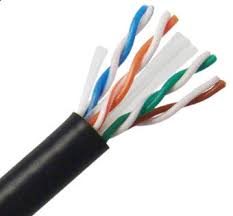The network cable jacket, often overlooked, is an important aspect of network infrastructure. It serves as the first line of defense, safeguarding the delicate wires within from environmental hazards and mechanical stress.
This article delves into the essence of network cable jackets, unraveling their importance in preserving the integrity and performance of network cables. We will explore the materials, design considerations, and the pivotal role they play in ensuring reliable and robust network connectivity.
In this article:
- What is the Network Cable Jacket?
- Historical Development
- Environmental Considerations
- Advanced Material Science
- Specialized Use Cases
- References
1. What is the Network Cable Jacket?
A network cable jacket is the outermost layer of network cabling, designed to provide physical protection and environmental resistance. It is the outer covering of the cabling that protects it from physical damage. The jacket of a cable protects the wiring from various kinds of damage, including:
- Damage caused by exposure to sun, heat, moisture, dust, and chemicals
- Damage caused by contact with sharp edges of walls, furniture, or plenum ducts; by mechanical vibrations; or by mechanical stresses introduced during the cable installation process

The jacket is usually made of an insulating material, although its primary purpose is not insulation. (This function is provided by insulating individual wires within the jacket.)
Common materials used for cable jackets include the following:
- Polyvinyl chloride (PVC): This is the most common material used for cable jackets. PVC is a tough, fire-resistant material formed from resins and plastics that can withstand a wide range of temperatures. PVC cables are typically used in vertical rises, but they should not be used in plenums because PVC gives off toxic fumes when burned.
- Kynar plastic (polyvinylidene fluoride): This material has good fire-retardant qualities, which makes it suitable for installation in plenums, but it is several times more costly than polyvinyl chloride.
- Flamarrest: This chloride compound has high fire retardance and is suitable for plenum installations.
- Neoprene: This dark-colored plastic is resistant to moisture and doesn’t degrade in sunlight. It’s a good choice for use in outdoor cable runs.
- Polyethylene: This soft, moisture-resistant plastic has poor fire retardance and is suitable only for outdoor cable runs.
2. Historical Development
The evolution of cable jacket materials and designs is a testament to the strides made in material science. Initially, cable jackets were primarily designed for basic protection against physical damage. As technology progressed, the focus shifted to more advanced materials that offered enhanced protection against environmental factors like moisture, chemicals, and extreme temperatures.
The transition from basic rubber or lead-based materials to modern polymers like PVC, Polyethylene, and Kynar reflects this advancement. These developments not only improved the durability and functionality of cable jackets but also addressed safety concerns, particularly in fire resistance and toxic emissions.
3. Environmental Considerations
The choice of network cable jacket material is heavily influenced by the environment in which the cable will be used. Indoor environments, for instance, often require jackets that are less robust but more flexible and cost-effective, like basic PVC. Outdoor cables, on the other hand, need jackets that can withstand harsh weather conditions, UV exposure, and temperature extremes, leading to the use of more resilient materials like Polyethylene.
In industrial settings, where cables might be exposed to chemicals, oils, or extreme physical abrasion, jackets made from materials like Neoprene or specialized flame-retardant compounds are preferred. Each environment dictates specific requirements that the cable jacket material must meet to ensure optimal performance and longevity.
4. Advanced Material Science
The field of material science has made significant contributions to the development of network cable jackets. Innovations in polymer chemistry have led to the creation of materials that offer enhanced durability, flexibility, and environmental resistance. For instance, thermoplastic elastomers (TPE) and thermoset compounds provide improved flexibility and heat resistance, making them ideal for various applications.
The focus has also shifted towards environmentally friendly materials, such as bio-based plastics, which reduce environmental impact without compromising performance. These advancements are crucial in meeting the evolving demands for network cabling in diverse and challenging environments.
5. Specialized Use Cases
Cable jackets designed for extreme environments illustrate the versatility of modern materials. For underwater applications, jackets need to be waterproof, pressure-resistant, and impervious to the corrosive effects of seawater, leading to the use of specialized polymers and sealing technologies.
In aerospace applications, cable jackets must withstand extreme temperatures and radiation while being lightweight and non-flammable, necessitating advanced materials like PTFE or Teflon. These specialized use cases demonstrate the critical role of advanced material science in addressing unique environmental challenges.
6. References
- “Polymer Science and Technology” by Joel R. Fried – a detailed overview of polymer chemistry and its applications.
- “Advanced Materials in Telecommunications” by various authors – insights into materials used in telecommunications, including cable jackets.